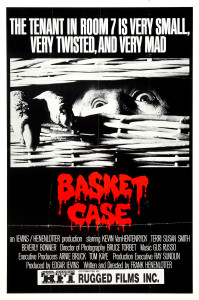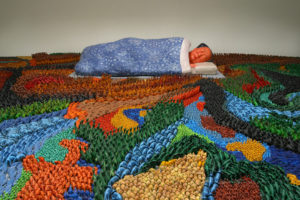Beyond the Hermeneutics of Desire: On the Vicissitudes of Lacan’s Concept of the Death-Drive
These reflections were included in Apropos of Nothing: Deconstruction, Psychoanalysis, and the Coen Brothers (SUNY, U.P.). They can be cited here as: Buckner, Clark. “Beyond the Hermeneutics of Desire: On the Vicissitudes of Lacan’s Concept of the Death-Drive.” www.clarkbuckner.com. Web. Day, Month, Year article as accessed.
While originally Lacan explains Freud’s concept of the death-drive in terms of the narcissistic aggression of the mirror-stage, in the 1950’s, he comes to conceive it rather, in terms drawn from structural linguistics and anthropology, as an effect of the constitutive negativity of the symbolic and the the relentless insistence of the signifying chain, which, he contends, define the unconscious as the discourse of the Other. Reflecting on Freud’s Beyond the Pleasure Principle, in “The Direction of the Treatment and the Principles of Its Power,” Lacan accordingly affirms Freud’s famous distillation of his grandson’s game to the verbal opposition Fort! Da! (Away! There!). He argues, “This is the point of insemination for a symbolic order that preexists the infantile subject and in accordance with which he has to structure himself” (Lacan, 1996; 497/594). At the same time, Lacan equates the death-drive with the dynamic anticipation that Heidegger conceives as Dasein’s “being-towards-death.” While praising Freud, in the same essay, he accordingly remarks, “Who, as fearlessly as this clinician, so firmly rooted in the everydayness of human suffering, has questioned life as to its meaning – not to say that it has none, which is a convenient way of washing one’s hands of the matter, but to say that it has only one, that in which desire is borne by death?” (Lacan, 1996; 536/642).[i]
By appealing to the primacy of the signifier, Lacan accounts for the radical variability that, Freud discerned as distinguishing human sexuality from mere animal instinct, by asserting the distortions of culture as not secondary, but rather fundamental to its constitution. He accounts for the paradigmatic erogenous zones, which psychoanalysts typically associate with distinct developmental “stages” – the oral, anal, and phallic – by explaining them as sites of the signifier’s cut, registered in the phenomenology of the body. And he preserves the dualism that Freud saw necessary to account for unconscious conflict, by conceiving desire as intrinsically divided between the differential negativity of the symbolic, and the objectivist identification of the imaginary. As the crux of what he later criticizes as the idealism of his own work, however, Lacan’s reformulation of Freud’s drive theory in terms of the primacy of the signifier suffers from, what Jacques-Alan Miller diagnoses as, a “confusion between the drive and desire” (Miller, 1996b; 422).
In his exposition of this “confusion,” Jacques-Alain Miller takes issue with Lacan’s exhaustive integration of “the drive into the schema of communication.” Echoing the central thesis of Lacan’s “structuralist period,” he protests, “the drive is completely constructed like an unconscious message” (Miller, 1997; 26) Attributing the negativity of the death-drive to the sundering of the symbolic, Lacan equates it with the lack of desire, while he explains drive-conflict (in fact, drive itself) as an effect of the derivative reduction of desire to demand. Correlative to his dissolution of the objectivity of the lost object in the formal negativity of the signifier, Lacan thus dispels the force of the drive, as a compulsive excitation, which chronically disturbs the subject’s self-possessed intentions. “Need, demand, desire,” Miller asks, “Where is the drive?” (Miller, 1997; 26) While desire emerges, “between the demand of need and the demand of love,” he adds, “there is a third: the demand of jouissance,” which refuses assimilation to the differential negativity of discourse alone (Miller, 1997; 26). While justifiably refusing the objectivist reduction of Freud’s concept to a quasi-biological theory of need, defined by the causal necessity of mechanical determinism, Lacan falls prey to the contrary error of idealistically “elevating” it to a purely symbolic theory of want, and so – despite the heteronomous dialectic of its constitution – conceiving it essentially as a form of intentionality, or even, freedom.
In more classical psychoanalytic terms, Lacan mistakenly assimilates the disturbing force of the death-drive’s negativity to the pleasure-principle’s homeostatic regulation of the psyche. Accordingly, when revising his critical theory, Lacan revisits the polemical confrontation with Jung that, among other things, compelled Freud to postulate the death-drive as the pleasure-principle’s “beyond.” Setting the stage for his argument, he reflects on the rise of modern science, as marked by the historical transition from astrology to astronomy. “The primitive science,” he contends, “is a sort of sexual technique” (Lacan, 1998; 150). Despite drawing significant conclusions about the stars, traditional astrology lacks the objectivity of astronomy, insofar as it conceives the universe as invested with meaning. Rather than merely factual, it thus understands the stars “erotically” as organized in terms of – and, in fact, actively reflecting – the relational dynamism of social relationships. The question, Lacan asks, is “whether we must regard the unconscious as a remanence of that archaic junction between thought and sexual reality?” (Lacan, 1998; 152). Despite the diamentrical opposition between Jung’s and Levi-Strauss’s theories, the question echoes Lacan’s critique of the anthropologist’s explanation of the unity of science and magic, on the basis of the symbolic division that differentiates all cultures from nature. In his elevation of psychoanalytic concepts to universal “archetypes,” Jung similarly restores the unity of astrology and astronomy, albeit not on the basis of the scientific rigor of his theory of the symbol, but rather by recuperating, “the level at which man’s thought follows those aspects of the sexual experience that have been reduced by the invasion of science” (Lacan, 1998; 153). That is, he conceives psychoanalysis as recuperating the repressed, “astrological” concept of the universe as a meaningful totality, in which empirical science finds its proper place.
While an empiricist might protest Jung’s eroticization of nature, in keeping with his “anxious” reaction to Levi-Strauss, Lacan’s contention firstly concerns the implications of his theory for the psychoanalytic concept of drive-conflict. Jungianism, he argues, “is necessarily accompanied by a repudiation of the term libido, by the neutralization of this function by recourse to a notion of psychical energy, a much more generalized notion of interest” (Lacan, 1998; 153). If psychoanalysis indeed registers the rise of modern, scientific self-consciousness, and the correlative repression of the symbolic systems of traditional society and religion, simultaneously it recognizes their speculative harmonies as indirect expressions of the strife in man’s relationship to himself, others, and the world. While Freud implicitly repudiates the scientistic ideology of 19th – Century postivism, by indeed recognizing an “archaic junction between thought and sexual reality,” in a decidedly modernist – even properly scientific – vein, he recognizes this junction as the locus of a conflict in each, and in their relationship to one another. By contrast, Jung’s restoration of the unity of thought and desire, not only on over-extends reason’s reach, but also dispels from desire the disturbing ex that qualifies it as sexual. Jung’s eroticization of nature, that is, depends upon purging from the libido that which makes it erotic.
Against this implication of his own earlier work, in his 1964 Seminar, Lacan, accordingly, insists that “the reality of the unconscious is sexual reality;” and he explains the force of the drive as an effect of the subject’s originary relationship to, neither the lack of desire, nor its derivative reduction to demand, but rather to the Real of the lost object (a), registered as jouissance (Lacan, 1998; 150). Prior to its articulation into the three voices, “active, passive, and reflexive,” Lacan argues that the drive is defined by a “movement outwards and back,” which he elaborates through the four-fold distinction that Freud draws in his Three Essays on Sexuality, by firstly locating its source in the body. Contrary to his earlier, exhaustive reduction of the unconscious to the “treasure-trove” of signifiers, Lacan thus conceives the subject as essentially corporeal. However, he does not therefore reduce to the drive to a quasi-naturalistic theory of instinct. As distinct from the rhythmic gratification of instinctual needs, the pressure of the drive is constant: the chronic disturbance of a relentless excitation. In keeping with the earlier account of the object (a), as the remainder of a cut in the real, (logically) prior to the sundering of the signifier, the force of the drive registers the subject’s division from the immediately given, natural world, at the level of its natural physiology. While not yet delimited by the symbolic prohibition, which constitutes desire, nevertheless the drives exceed the closed circuit of the instincts and the innate rhythm of their satisfaction. They are, as Zizek contends, “already ‘derailed nature’” (Zizek, 2005; 192).
In this regard, when locating the drive’s source in the body, Lacan implicitly conceives the body itself, as neither merely biological, nor merely phenomenological (i.e., symbolic), but rather, somewhere between the two – in fact, one might hypothesize, at the point of their irreducible mutual implication – as a field of compulsive excitations, constituted in its ultimate (in)coherence, by the ‘extimate,’ lost object (a). As distinct from the internal organs, which regulate the exigencies of the instincts, the organs of the drive thus lie on the body’s surface, at the “vanishing points where the inside meets the outside” (Jaanus, 1995; 120). Rhetorically, Lacan asks, “Why are the so-called erogenous zones recognized only in those points that are differentiated for us by their rim-like structure?” (Lacan, 1978; 169). Beyond the satisfaction of the organism’s natural needs, and yet prior to their symbolic mediation, the rims of the body’s orifices delimit the subject’s physical relationship to the world, as points of division, invested with the force of a craving, whose unqualified gratification would be the subject’s corporeal dissolution. At a strictly physical level, the force of the drive is thus most immediately evident in those enjoyments and excitations that run contrary to the body’s needs: insomnia, addiction, the masochistic self-flagellation of the workaholic.
While locating the source of the drive in the body, Lacan thus simultaneously distinguishes the object of the drive from the object of instinctual need. Whereas instincts entail a determinate relationship to their object, Lacan argues that the drive has no objective correlative. Citing Freud, he contends, “Look what he says, ‘As far as the object of the drive is concerned, let it be clear that it is, strictly speaking, of no importance. It is a matter of total indifference’ (Lacan, 1998; 168). The object of the drive is, according to Lacan, the Real of the lost object. Despite the force of its claim on the subject’s body, strictly speaking, it thus amounts only to “a hollow, a void,” for which objects of instinctual gratification (among others) only secondarily serve as surrogates (Lacan, 1978; 180). Lacan contends, “No food will ever satisfy the oral drive, except by circumventing the eternally lacking object” (Lacan, 1978; 180).
Bringing together the “void” of the drive’s object with the “rim” of its source, Lacan depicts the force of the drive in a vivid image. “Even when you stuff the mouth – the mouth that opens in the register of the drive –“ he contends, “its is not the food that satisfies it, it is, as one says, the pleasure of the mouth” (Lacan, 1978; 167 – 168). As conspicuous, for instance, in the clinical and cultural phenomena of over-eating, the drive does is not sated by the objects on which it is brought to bear, but rather always demands more, another. At the point where over-eating meets anorexia, the object of the drive lies rather in the absence of the remainder: its satisfaction is correlative with its dissatisfaction, as the enjoyment of the craving. Accordingly, Lacan explains the aim of the drive as the circumnavigation of the object. The drive, he puns, “fait la tour” (Lacan, 1978; 168). The expression literally means “to go around,” but also is used idiomatically to mean “to trick.” While brought to bear upon objects of instinctual gratification (among others), the drive does not find satisfaction in consumption, or even, strictly speaking, consummation. As further explaining the constancy of its pressure, it instead “tricks” the object into serving as a stand-in for the lost object (a), and finds its satisfaction only in the dissatisfaction of repeating the out and back of its circuit. While repudiating his earlier assertion of the primacy of the signifier’s lack, Lacan thus conceives the drive itself as the efficacy of an originary negativity. Rooted in the rims of the body’s orifices, the drive relentlessly circumnavigates a categorically lost object, accomplishing nothing. Contrary to his earlier theory, however, Lacan does not conceive the absence of the drive privatively, but rather as the imposing presence of a visceral excitation, whose “lack of lack,” renders it impossible to directly determine.
[i] Explaining Lacan’s appropriation of Heidegger’s concept, Charles Shepherdson argues that death, “involves a peculiar link between the symbolic and the real, presenting us with a sort of hole or void in the structure of meaning – a void that is not a deficiency, but virtually the opposite, an absolute condition of meaning” (Shepherdson, 2008; 3).




